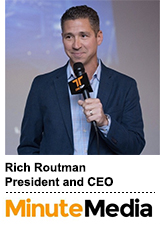 When the sports news startup Minute Media was founded seven years ago, Bleacher Report, Huffington Post and other publishers already had demonstrated user-generated content and social traffic growth strategies before ditching the model for more traditional newsrooms.
When the sports news startup Minute Media was founded seven years ago, Bleacher Report, Huffington Post and other publishers already had demonstrated user-generated content and social traffic growth strategies before ditching the model for more traditional newsrooms.
Minute Media wants to prove a new media company can stick with its contributors and generate returns by spinning its editorial platform into influencer marketing and technology licensing businesses.
Minute Media operates the US-focused sports news site 12up, esports news page DBLTAP and the soccer – ahem, football – publisher 90min. It has raised $76 million from investors such as Goldman Sachs, Battery Ventures and ProSieben, a German broadcaster and strategic partner, including a $17 million Series F round in May.
A key reason Minute Media continues to attract investors despite headwinds in the media category is that 30% of its revenue comes from software subscription and technology services, which insulates the startup from the vagaries of online advertising.
Minute Media and ProSieben formed a joint media company to cover German football, with Minute Media providing content and publishing infrastructure while ProSieben brings its distribution. Minute Media also licenses its tech as a more straightforward SaaS service to Turner’s Esporte Interativo in Brazil and news publisher HT Media in India.
“It’s a unique and different approach to being a viable media company,” said Rich Routman, Minute Media’s president and CRO.
AdExchanger spoke with Routman about the company’s growth opportunities.
AdExchanger: As a news publisher, how did you end up licensing technology to other media companies?
RICH ROUTMAN: We built the product to use ourselves because we needed scalable tech to allow content creators to be a part of our system. So, we developed the core CMS [content management system]. It has a lot of individual tools we needed and that other newsrooms were becoming more interested in, like seamlessly being able to bring in content from YouTube, Twitter and other video platforms.
Most of the opportunities found us.
Esporte Interativo, for instance, has lots of internal content creators and outside contributors, and I think this system helps modernize the newsroom. We’re also very mobile-focused with our content, so we have video products to use 2G connections, which is very important in Brazil. Broadcasters are scaling up digital media content but don’t necessarily want to spend millions on digital studio production, so licensing tech like this is an effective way to modernize the newsroom tech.
How does that tech business factor into your growth plans?
It’s not about making SaaS sales grow to be more than 30% of revenue, where it is now. We’re focused on maintaining it at around 30%.
But that 30% of revenue comes from just a handful of media companies. So we’re not outselling the tech aggressively to all sorts of publishers. It’s more of a focus on unbundling services, like our video player, content curation or programmatic influencer activation to make them available to customers.
If we can keep the tech sales at about 30% as our overall revenue scales toward $100 million in the next year or two, that lets us do some really unique and different things.
With all the challenges in the business today, some quality brands that have been around a long time haven’t been able to sustain profitability. So it means we can send a message to the market that we want to be a buyer and can collect and do more with those assets.
Some of the best-known media startups started as mostly user-generated content and sifted into building up their own newsrooms. You’ve stuck with that contributor model. How does that look?
We don’t think of influencers the same way others in the space do, where it’s about going out and finding whichever social accounts are a good fit for whatever campaign you’re working on. But our contributors, and we work with more than 1,000 people on that, have grown into a strong influencer marketing asset.
We’re sending a lot of fans to the World Cup on behalf of brands, for instance. One automotive campaign will follow fans as they travel to World Cup, and a beer brand will bring influencers from lots of nations to watch the games together.
For us the strategy is more about community, content and distribution than marketing revenue. When we’re doing it right there’s a non-transactional element to our relationship with content creators because we need to be producing content and growing the audience regardless of campaigns we may be working on.
It strengthens our advertising offer as well. If Chelsea [a British football club] wants to find known fans in other countries for a marketing push, we have those communities in place and can reach them effectively and know what those audiences look like.
For World Cup brands in the US this year, the funding has mostly come from Hispanic audience media budgets. [The US men’s team didn’t qualify.] That’s a community we’ve been focused on growing for some time. So we have the influencer roster there, but also just know how to target and reach the audience.
Follow James Hercher (@JamesHercher) and AdExchanger (@adexchanger) on Twitter.
This post was syndicated from Ad Exchanger.

More Stories
M+AD takes break for Anzac Day commemoration
Sustainability Is More Than a Big Leafy Green Picture
Google Won’t Pull Cookies In 2024